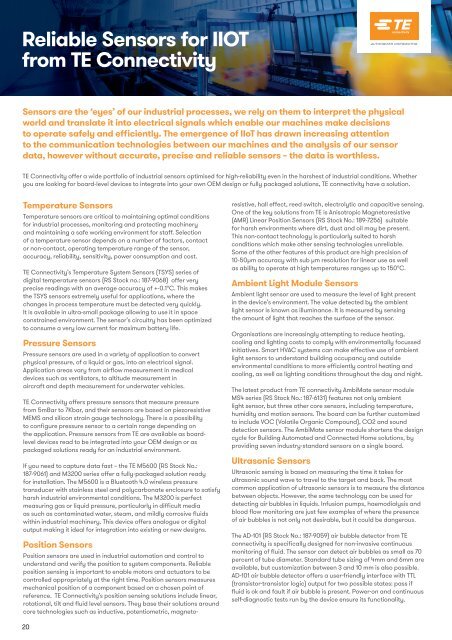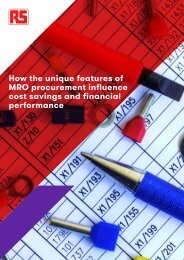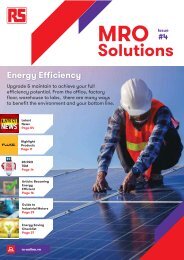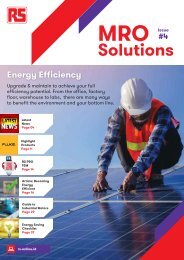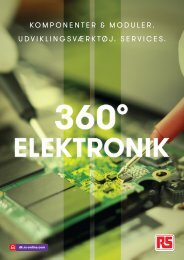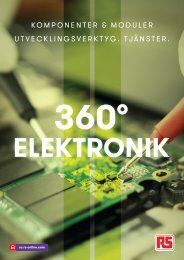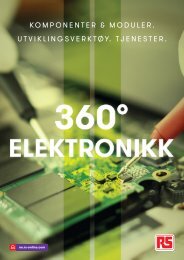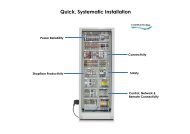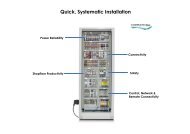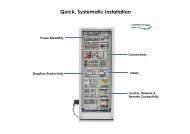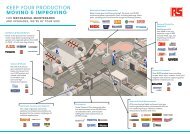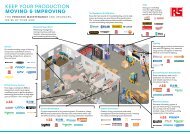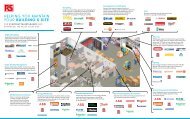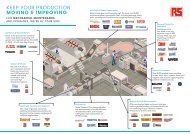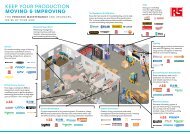Electronic Solutions TH
Create successful ePaper yourself
Turn your PDF publications into a flip-book with our unique Google optimized e-Paper software.
Reliable Sensors for IIOT<br />
from TE Connectivity<br />
Sensors are the ‘eyes’ of our industrial processes, we rely on them to interpret the physical<br />
world and translate it into electrical signals which enable our machines make decisions<br />
to operate safely and efficiently. The emergence of IIoT has drawn increasing attention<br />
to the communication technologies between our machines and the analysis of our sensor<br />
data, however without accurate, precise and reliable sensors – the data is worthless.<br />
TE Connectivity offer a wide portfolio of industrial sensors optimised for high-reliability even in the harshest of industrial conditions. Whether<br />
you are looking for board-level devices to integrate into your own OEM design or fully packaged solutions, TE connectivity have a solution.<br />
Temperature Sensors<br />
Temperature sensors are critical to maintaining optimal conditions<br />
for industrial processes, monitoring and protecting machinery<br />
and maintaining a safe working environment for staff. Selection<br />
of a temperature sensor depends on a number of factors, contact<br />
or non-contact, operating temperature range of the sensor,<br />
accuracy, reliability, sensitivity, power consumption and cost.<br />
TE Connectivity’s Temperature System Sensors (TSYS) series of<br />
digital temperature sensors (RS Stock no.: 187-9068) offer very<br />
precise readings with an average accuracy of +-0.1°C. This makes<br />
the TSYS sensors extremely useful for applications, where the<br />
changes in process temperature must be detected very quickly.<br />
It is available in ultra-small package allowing to use it in space<br />
constrained environment. The sensor’s circuitry has been optimized<br />
to consume a very low current for maximum battery life.<br />
Pressure Sensors<br />
Pressure sensors are used in a variety of application to convert<br />
physical pressure, of a liquid or gas, into an electrical signal.<br />
Application areas vary from airflow measurement in medical<br />
devices such as ventilators, to altitude measurement in<br />
aircraft and depth measurement for underwater vehicles.<br />
TE Connectivity offers pressure sensors that measure pressure<br />
from 5mBar to 7Kbar, and their sensors are based on piezoresistive<br />
MEMS and silicon strain gauge technology. There is a possibility<br />
to configure pressure sensor to a certain range depending on<br />
the application. Pressure sensors from TE are available as boardlevel<br />
devices read to be integrated into your OEM design or as<br />
packaged solutions ready for an industrial environment.<br />
If you need to capture data fast – the TE M5600 (RS Stock No.:<br />
187-9061) and M3200 series offer a fully-packaged solution ready<br />
for installation. The M5600 is a Bluetooth 4.0 wireless pressure<br />
transducer with stainless steel and polycarbonate enclosure to satisfy<br />
harsh industrial environmental conditions. The M3200 is perfect<br />
measuring gas or liquid pressure, particularly in difficult media<br />
as such as contaminated water, steam, and mildly corrosive fluids<br />
within industrial machinery. This device offers analogue or digital<br />
output making it ideal for integration into existing or new designs.<br />
Position Sensors<br />
Position sensors are used in industrial automation and control to<br />
understand and verify the position to system components. Reliable<br />
position sensing is important to enable motors and actuators to be<br />
controlled appropriately at the right time. Position sensors measures<br />
mechanical position of a component based on a chosen point of<br />
reference. TE Connectivity’s position sensing solutions include linear,<br />
rotational, tilt and fluid level sensors. They base their solutions around<br />
core technologies such as inductive, potentiometric, magnetoresistive,<br />
hall effect, reed switch, electrolytic and capacitive sensing.<br />
One of the key solutions from TE is Anisotropic Magnetoresistive<br />
(AMR) Linear Position Sensors (RS Stock No.: 189-7256) suitable<br />
for harsh environments where dirt, dust and oil may be present.<br />
This non-contact technology is particularly suited to harsh<br />
conditions which make other sensing technologies unreliable.<br />
Some of the other features of this product are high precision of<br />
10-50µm accuracy with sub µm resolution for linear use as well<br />
as ability to operate at high temperatures ranges up to 150°C.<br />
Ambient Light Module Sensors<br />
Ambient light sensor are used to measure the level of light present<br />
in the device’s environment. The value detected by the ambient<br />
light sensor is known as illuminance. It is measured by sensing<br />
the amount of light that reaches the surface of the sensor.<br />
Organisations are increasingly attempting to reduce heating,<br />
cooling and lighting costs to comply with environmentally focussed<br />
initiatives. Smart HVAC systems can make effective use of ambient<br />
light sensors to understand building occupancy and outside<br />
environmental conditions to more efficiently control heating and<br />
cooling, as well as lighting conditions throughout the day and night.<br />
The latest product from TE connectivity AmbiMate sensor module<br />
MS4 series (RS Stock No.: 187-6131) features not only ambient<br />
light sensor, but three other core sensors, including temperature,<br />
humidity and motion sensors. The board can be further customized<br />
to include VOC (Volatile Organic Compound), CO2 and sound<br />
detection sensors. The AmbiMate sensor module shortens the design<br />
cycle for Building Automated and Connected Home solutions, by<br />
providing seven industry-standard sensors on a single board.<br />
Ultrasonic Sensors<br />
Ultrasonic sensing is based on measuring the time it takes for<br />
ultrasonic sound wave to travel to the target and back. The most<br />
common application of ultrasonic sensors is to measure the distance<br />
between objects. However, the same technology can be used for<br />
detecting air bubbles in liquids. Infusion pumps, haemodialysis and<br />
blood flow monitoring are just few examples of where the presence<br />
of air bubbles is not only not desirable, but it could be dangerous.<br />
The AD-101 (RS Stock No.: 187-9059) air bubble detector from TE<br />
connectivity is specifically designed for non-invasive continuous<br />
monitoring of fluid. The sensor can detect air bubbles as small as 70<br />
percent of tube diameter. Standard tube sizing of 4mm and 6mm are<br />
available, but customization between 3 and 10 mm is also possible.<br />
AD-101 air bubble detector offers a user-friendly interface with TTL<br />
(transistor-transistor logic) output for two possible states: pass if<br />
fluid is ok and fault if air bubble is present. Power-on and continuous<br />
self-diagnostic tests run by the device ensure its functionality.<br />
20


